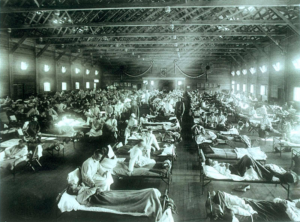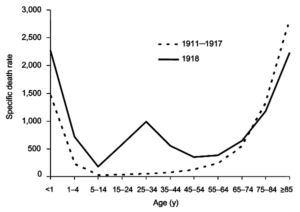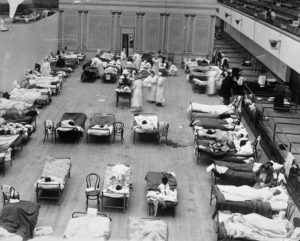
By Syed Masood
The recent coronavirus outbreak in China, which has now become a global pandemic, has shown the world how interconnected our lives are in the 21st century. However, the coronavirus outbreak has also shown the great lengths humanity has taken to better regulate these diseases. Two quintessential examples are the Chinese government building a fully functional hospital in ten days and the quarantine procedure set in place that should inhibit the further spread of the disease. These are great feats and show how humans have developed the ability to deal with situations like the coronavirus outbreak, as well as the 2014 Ebola outbreak and the 2009 Swine flu pandemic. However, this was not always the case.

A little over a century ago, one of the deadliest pandemics in the world transpired in 1918: the infamous Spanish flu. The Spanish flu was a unique strain of the flu, the H1N1 strain (the same as the 2009 swine flu outbreak), where the highest fatalities occurred not only in the elderly and the young like the normal flu but also in individuals in their prime. Indeed, 99% of the deaths due to the disease occurred in individuals under the age of 65, with nearly half being between the ages of 20 and 40. Approximately 500 million individuals across the globe were infected, and the death toll was estimated to be 50 million individuals, or about 3% of the world’s population. However, the global impact of the 1918 pandemic was lost and is often called the “forgotten pandemic.”
The 1910s saw the assassination of Archduke Franz Ferdinand and the outbreak of World War I, the sinking of the Titanic, the Treaty of Versailles and the end of the World War I, the collapse of the German and Ottoman empires, and the Russian revolution, on top of the forgotten pandemic. The first wave of the flu broke out during the war, and thus, countries involved in World War I downplayed the illness and minimized reporting of the disease. Spain was neutral in the war at the time. As a result, King Alonso of Spain did not inhibit the press from reporting about the rampant cases of the flu. Thus, it appeared as if Spain was affected the most by the outbreak resulting in the pandemic’s nickname the “Spanish flu.”

The Spanish flu hit the world in three waves. The first wave was typical of the normal flu, where the young and old were infected but those that were healthy easily recovered and started gaining immunity for the second wave. However, the virus mutated to a much deadlier form, causing worldwide panic. The virus was incredibly infectious, and the conditions of World War I only helped the virus spread. Soldiers on the fronts of the war were under severe stress and malnourished, helping the virus evade the host’s immune system. Furthermore, individuals infected with the flu had to travel to crowded train stations and crowded field hospitals causing further spread of the deadlier strain.

The disease was incredibly lethal. The symptoms of the victims suffering from the flu were gruesome: hemorrhages in the lungs causing the victims to drown in their own fluids, the lack of oxygen turning their faces blue, and raging cytokine storms throughout their body, created a lethal combination. The disease was devastating. Most deaths, however, were associated with bacterial pneumonia, a common secondary infectious disease associated with influenza.
The outbreak of the Spanish flu occurred during an era of war and conflict. Mixed in with lack of public knowledge regarding the spread of disease, extended close contact soldiers, and a deadlier version of the typical flu, the Spanish flu spread like wildfire across the world. The Spanish flu of 1918 was one the deadliest pandemics in history, occurring a little over a century ago. While the coronavirus today is also a highly infectious disease, we have become increasingly sophisticated in dealing with and preventing these pandemics. With a better understanding of disease spread, enhanced protocols and procedures to limit the spread of infectious diseases, and newer infrastructure to accommodate the sick, we have progressed greatly in dealing with potential outbreaks. This is a great sign for public health.
Peer edited by Fanting Kung and Eliza Thulson
It is a very well researched article. The student has thoroughly analyzed the outbreak of virus. He must be congratulated.
Complete and accurate, easy to understand with excellent background knowledge & expertly researched and written